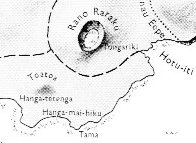9. The 13th kuhane 'station' (as I am going to call them from now on) was named Tama, with the peculiar addition he ika kino he ihu roroa ('the evil fish with a very long nose'). In a way it marks the end of the southern shore because it lies directly south of Rano Raraku:
The dream soul went on. She was careless (?) and broke the kohe plant with her feet. She named the place 'Hatinga Te Koe A Hau Maka O Hiva'. The dream soul went on and came to Roto Ire Are. She gave the name 'Roto Ire Are A Hau Maka O Hiva'. The dream soul went on and came to Tama. She named the place 'Tama', an evil fish (he ika kino) with a very long nose (he ihu roroa).
13 lunar months is the necessary distance in time in order to contain the length of a solar year, 12 * 29.5 = 354 is not enough. I am here suggesting the possibility of each kuhane station representing a lunar month. Furthermore, Tama evokes the idea of Sun because he was called Tama nui te ra ('Great Son of the Day'), we know from a Maori myth about Maui forcing Sun to slow down. Possibly this Great Son of the Day refers to the Sun of midsummer - when he evidently is slowing down - and maybe the kuhane station Tama somehow corresponds to 'noon', the zenith point of Sun's path across the sky. Moon is in every respect the opposite of Sun and when Sun moves from east to west Moon is making her journey in the opposite direction, i.e. moving like the kuhane of Hau Maka. If we assume each kuhane station corresponds not only to a lunar month but also to a night in the month - which is quite possible because it would 'map' time onto itself in a beautiful and economic pattern - then we can compare Tama with the 13th night of the month according to the earlier mentioned Hawaiian calendar:
The name of the 13th Hawaiian night is Hua, meaning 'fruit', i.e. something quite similar to Tama ('son'). |
